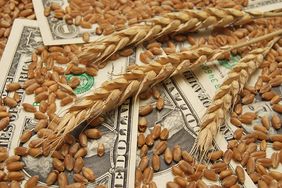:max_bytes(150000):strip_icc()/35570080425_8b4760d942_c2-2-5d14680eab5842bebd8dca8b1889ef77.jpg)
1. Wheat futures drop in overnight trading
Wheat plunged in overnight trading on technical selling as investors who held bullish positions liquidated their positions and booked profits after a recent runup in prices.
Futures had been rising on concerns about dry weather in the U.S. southern Plains where little or no rain has fallen in the past two weeks.
Stripe rust in wheat also has been reported statewide in Kansas, the biggest U.S. producer of winter varieties, according to the Kansas State University Wheat and Forage Extension Pathology program.
“Several reports of stripe rust have come in over the last week, mostly at low or trace levels due to drought conditions,” the group said on social media. “Fields still within the window for a fungicide application should be scouted.”
Still, drought conditions eased in the week through April 30, according to the U.S. Drought Monitor.
About 56% of Kansas was suffering from drought conditions at the end of last month, down from 65% a week earlier. That’s still up from the 38% that was seeing drought three months ago, the monitor said.
In Russia, dry weather has curbed prospects for wheat.
The country's wheat crop was downgraded by consultancy IKAR to 91 million metric tons from a previous outlook for 93 million tons.
USDA last month pegged Russian wheat production at 91.5 million metric tons, unchanged month to month but down slightly from the 91 million tons that was collected a year earlier.
Soybeans were modestly lower overnight despite deadly floods that swept through parts of Brazil, damaging fields and leaving the size of the country’s crop in question.
Floods in the state of Rio Grande do Sul, a major producer of soybeans, killed around 75 people and injured at least 100 people, according to local media reports, citing local government officials.
Almost 90,000 people evacuated their homes, the reports said.
As much as a foot of rain fell in the week through Thursday, according to the Brazilian Meteorology Institute. Some fields are still under water as are equipment and structures.
The U.S. Department of Agriculture last month said it expects soybean production in Brazil of 155 million metric tons this year. Analysts had expected the agency to lower its forecast amid adverse weather in the South American country.
Consultancy Conab, however, lowered its forecast last month to 146.5 million metric tons.
About 40% of soybeans in the center and south of Rio Grande do Sul are still in fields, Reuters reported.
Wheat futures for July delivery fell 9¢ to $6.13½ a bushel overnight on the Chicago Board of Trade, and Kansas City futures dropped 16½¢ to $6.33¾ a bushel.
Soybean futures for July delivery lost 3¼¢ to $12.11¾ a bushel. Soymeal was down $1.70 to $370.50 a short ton, and soy oil gained 0.38¢ to 43.46¢ a pound.
Corn futures fell 1¾¢ to $4.58½ a bushel.
2. Investors cut net short positions in corn, wheat
Money managers cut their net short positions, or bets on lower prices, in corn to the lowest level since the beginning of the year, according to data from the Commodity Futures Trading Commission.
Investors held 213,115 futures contracts in corn in the seven days that ended on April 30, CFTC said in a report.
That’s down from 225,943 contracts a week earlier and marks the smallest bearish position since the week that ended on Jan. 2.
Speculators held a net 141,237 futures contracts in soybeans last week, up from 138,678 a week earlier, the agency said.
In wheat, hedge funds and other large investment firms held a net short position of 29,352 contracts in hard red winter wheat. That’s down from 47,814 contracts a week earlier and the smallest such position since Dec. 19.
Investors reduced their net shorts in soft red winter wheat to 49,629 futures contracts, down from 75,542 seven days earlier. That's the smallest such position since July 25, CFTC said in its report.
The weekly Commitment of Traders report from the Commodity Futures Trading Commission shows trader positions in futures markets.
The report provides positions held by commercial traders, or those using futures to hedge their physical assets; noncommercial traders, or money managers (also called large speculators); and nonreportables, or small speculators.
A net long position indicates more traders are betting on higher prices, while a net short position means more are betting futures will decline.
3. Dry weather forecast for the southern Plains
Red flag warnings have been issued for parts of the southern Plains while strong winds are forecast for the Dakotas, according to the National Weather Service.
Winds in southwestern Kansas and the Oklahoma and Texas panhandles will be sustained from 20 to 30 mph with gusts of up to 45 mph in the forecast, the agency said in a report early this morning.
Relative humidity will fall as low as 7%.
In central South Dakota, meanwhile, winds will range from 20 to 30 mph today and tonight with gusts of around 50 mph expected, NWS said.
“Gusty winds will blow around unsecured objects,” the agency said. “Three limbs could be blown down and a few power outages may occur.”









